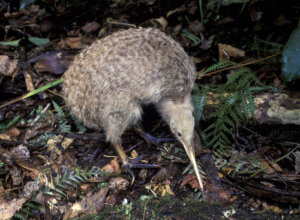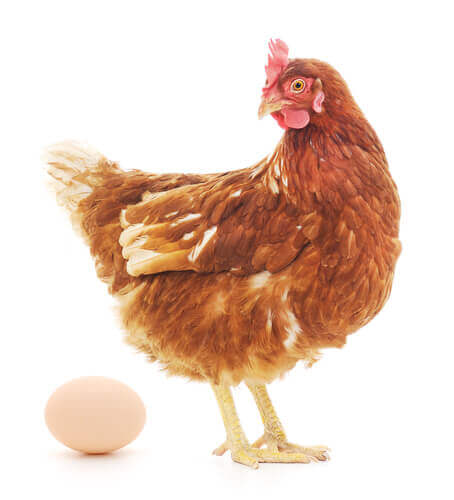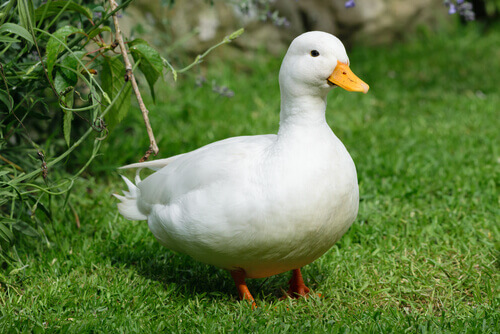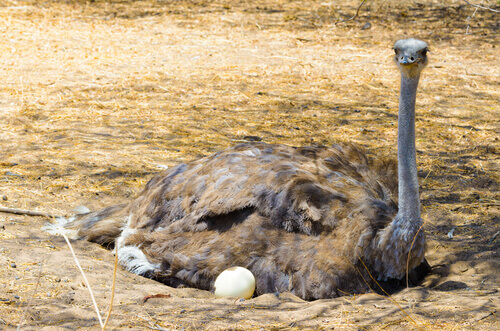Discover These 5 Birds That Don't Fly

Although they have wings, therer are some birds that don’t fly. Or, if they do, they only rise a few centimeters from the ground. We’ll tell you all about them in the article below.
What are the birds that don’t fly?
Non-flying birds, as their name suggests, are those that don’t have the ability to fly. The good news is that they’ve adapted to the environment in which they live. Therefore, in order to move, feed ,or escape from danger, they swim or run very fast.
The main anatomical difference between a bird that does fly and one that doesn’t is the size of its wing bones. In other words, birds that don’t fly have smaller wing bones. In addition, non-flying birds don’t have a keel on their chests, which allows other birds to move their pectoral muscles in the air. And, finally, they have more feathers on their bodies, because they don’t need to reduce their weight to get up.
Some examples are:
1. Kiwi
The kiwi, which appears in this article’s cover photo, is an endemic animal of New Zealand. It’s small in size and round in shape. Its small wings are hidden under the thick brown plumage and it hardly moves them.
This is a very shy bird, with nocturnal habits. It feeds on insects, invertebrates, worms -which it hunts with its long beak- and some plants. One interesting fact about this animal is that the female can lay an egg that’s large in relation to her body.
2. Chicken
This chicken is one of the most famous flightless birds and also the most numerous on the planet. It’s an omnivorous species that can live up to 10 years and has been domesticated for its meat and eggs.

3. Penguin
Although it can’t fly, the penguin is one of the best swimmers there is. Its wings and body shape allow it to dive to great depths in search of food.

There are no visible differences between male and female specimens, and they’re monogamous. They only have one offspring per season. In most cases, the parents incubate the eggs and protect them from adverse weather. Penguins feed on fish and plankton.
4. Domestic duck
This is another one of the birds that don’t fly that’s very popular around the world. Its temperament is affable and, therefore, it’s one of the favorites among barnyard animals.

It lives in rivers, lakes, lagoons, and even in pools and freshwater ponds. To nest, it chooses dry sites, among grasslands or bushes. The female lays between 4 and 12 eggs and incubates them for almost a month. At birth, the chicks are covered with a yellow or black down.
5. Ostrich
The largest bird in the world doesn’t have the ability to fly due to its size. However, nature has provided it with another advantage. Ostriches can run at a very fast speed (about 43 mph) thanks to their long legs with only two toes. Their small wings help it to propel itself, balance, and defend itself from predators.

The ostrich egg weighs about two kilos -equivalent to a dozen chicken eggs- and is white or yellow in color. Once the females have laid their eggs, the male is in charge of covering them up. It’s worth noting that in this species, males they have harems of up to five partners.
https://myanimals.com/es/5-aves-que-no-vuelan/
Although they have wings, therer are some birds that don’t fly. Or, if they do, they only rise a few centimeters from the ground. We’ll tell you all about them in the article below.
What are the birds that don’t fly?
Non-flying birds, as their name suggests, are those that don’t have the ability to fly. The good news is that they’ve adapted to the environment in which they live. Therefore, in order to move, feed ,or escape from danger, they swim or run very fast.
The main anatomical difference between a bird that does fly and one that doesn’t is the size of its wing bones. In other words, birds that don’t fly have smaller wing bones. In addition, non-flying birds don’t have a keel on their chests, which allows other birds to move their pectoral muscles in the air. And, finally, they have more feathers on their bodies, because they don’t need to reduce their weight to get up.
Some examples are:
1. Kiwi
The kiwi, which appears in this article’s cover photo, is an endemic animal of New Zealand. It’s small in size and round in shape. Its small wings are hidden under the thick brown plumage and it hardly moves them.
This is a very shy bird, with nocturnal habits. It feeds on insects, invertebrates, worms -which it hunts with its long beak- and some plants. One interesting fact about this animal is that the female can lay an egg that’s large in relation to her body.
2. Chicken
This chicken is one of the most famous flightless birds and also the most numerous on the planet. It’s an omnivorous species that can live up to 10 years and has been domesticated for its meat and eggs.

3. Penguin
Although it can’t fly, the penguin is one of the best swimmers there is. Its wings and body shape allow it to dive to great depths in search of food.

There are no visible differences between male and female specimens, and they’re monogamous. They only have one offspring per season. In most cases, the parents incubate the eggs and protect them from adverse weather. Penguins feed on fish and plankton.
4. Domestic duck
This is another one of the birds that don’t fly that’s very popular around the world. Its temperament is affable and, therefore, it’s one of the favorites among barnyard animals.

It lives in rivers, lakes, lagoons, and even in pools and freshwater ponds. To nest, it chooses dry sites, among grasslands or bushes. The female lays between 4 and 12 eggs and incubates them for almost a month. At birth, the chicks are covered with a yellow or black down.
5. Ostrich
The largest bird in the world doesn’t have the ability to fly due to its size. However, nature has provided it with another advantage. Ostriches can run at a very fast speed (about 43 mph) thanks to their long legs with only two toes. Their small wings help it to propel itself, balance, and defend itself from predators.

The ostrich egg weighs about two kilos -equivalent to a dozen chicken eggs- and is white or yellow in color. Once the females have laid their eggs, the male is in charge of covering them up. It’s worth noting that in this species, males they have harems of up to five partners.
https://myanimals.com/es/5-aves-que-no-vuelan/
This text is provided for informational purposes only and does not replace consultation with a professional. If in doubt, consult your specialist.








